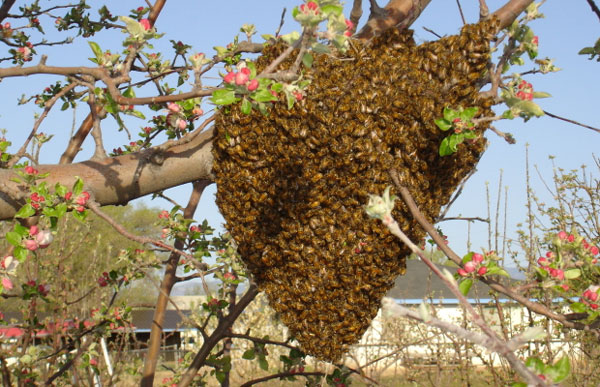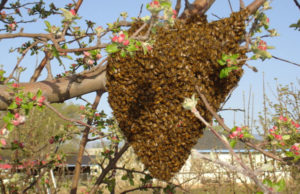This has been the spring to start colonies by hiving a swarm. The mild winter meant fewer overwintering losses (see results for WVBA backyard beekeepers posted here and on www.pnwhoneybeesurvey.com) together with our mild spring, providing abundant pollen and nectar foraging conditions, has resulted in numbers of swarms. Reports of colonies swarming more than once have been common.
Although “free” bees, capturing a swarm to start a colony presents a challenge to the bees and beekeepers. Desired result is a colony that might be strong enough with adequate reserves to overwinter. Earlier swarm captures and hiving large sized swarms helps. We are aware that in nature, only 1 in 5 feral nests survives the first winter.
For beekeepers, swarms represent a good opportunity to start a new colony, especially if the swarm is not from one of your hives. They are “free” bees. Like a new package or nuc hive, swarms (and hive splits) can benefit from beekeeper attention to improve their chances of overwintering successfully. Early swarms and bigger-sized swarms have the best survivability odds but using smaller swarms to bolster weaker overwintered colonies or putting several swarms together to develop a stronger colony are all welcome apiary additions in the spring.
One unique feature of a swarm-capture developed colony is they are going to have a queen issue to resolve. Primary swarms (first swarms to issue from a colony), have older queens, the original hive queen. Original queens will soon be superseded. Once hived, some will not properly requeen, ending up queenless. Afterswarms or secondary swarms may have multiple virgin queens and will not be queenright (i.e. have mated laying queen) for 2 or more weeks. Some of the earliest colonies that swarmed result in no or poor virgin queen mating due to variable spring weather and lack of sufficiently large enough drone populations.
Swarming is colony reproduction – one family becomes two (or more) when the parent colony swarms. Reproduction is basic to living organisms. Our bee stewardship is often directed toward reducing the possibility of our colonies swarming. However we lack good clues that a colony is preparing to swarm until they have started (and often are well into) swarming preparations, so our success in halting swarming is and remains a big challenge.
Swarm prevention seeks to provide a hive atmosphere that does not lead to swarming. Prevention begins by having younger-aged queens, queens that have not gone through a heavy spring buildup. Colonies with older-aged queens have a much greater probability to start replacement daughters and swarm, than colonies with younger queens. It is all about keeping up with the amount of queen pheromones required by every worker on a daily basis. This means summer queen replacement since there is too little time during spring buildup to requeen colonies in the spring.
Hives need good ventilation with brood-box frames of mainly worker cell. We should help the bees with plenty of room for expansion of the brood cluster and no constriction of brood expansion or compacting (congestion) of the worker adult population to too small a space in the brood area. The queen needs to have enough cells to lay around 1000 eggs daily. This means worker cells cleaned and ready on 2 or more frames. By late spring the brood should occupy 70% or more of up to 10-15 frames in healthy, developing colony populations.
Our challenge this spring has been the early jump-start of spring by our bees. Our late spring colonies should still have room for brood expansion and adequate space for the growing population. The colony should have a young queen. Good bee stewardship seeks is to provide the ideal conditions in the hive we keep our bees so the colony does not begin to rear replacement queens. We are often behind – anticipation is the key to good bee stewardship.


